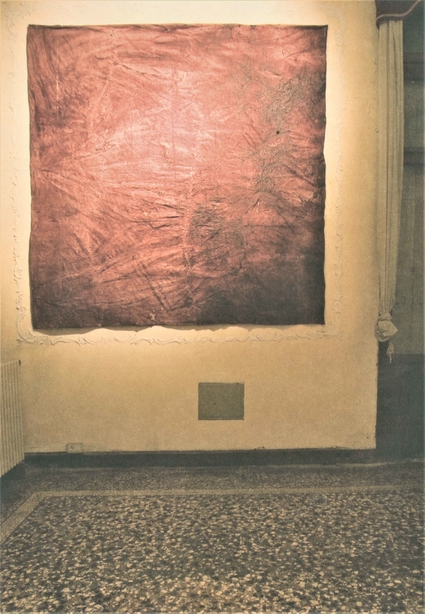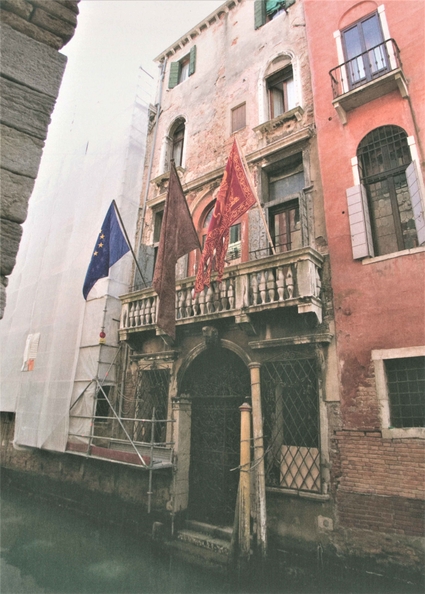Teresa is an artist from Culiacán, Mexico, who also did a training in forensics. She creates sensory experiences from materials found in crime scenes, morgues and sites of violence or forced displacement. In the ’90s, Margolles started to go inside morgues in Mexico City and bringing body remains of people who had a violent death and whose cases were lost in the darkness of the morgue, to art institutes.
She has been using the secretions of the body for a unique purpose. Her aim is not to create a productive result from our blood, or to transform our personal relationship with the secretions of our body. Instead her work proposes a point of viewing secretions that brings gaze towards the bodies of others, in particular towards the bodies that have been wounded by violence.
In her pieces, Vaporización (2002) and En el Aire (2003), Margolles confronts the visitor with dead in an unusual way. It is more common to see the traces or rests of the past by looking at photographs, writings, or objects. But in this case, the exposure to death is surprisingly and terrifyingly aesthetic. The first work concerns a room full of steam, where you walk through a dense fog that fills the gallery and that produces a visual, tactile and olfactory experience of density. Later, you learn that this mist comes from the vaporisation of disinfected water that was used to clean corpses of drug war victims in Mexico.
Also the work, En el Aire (2003) (In the Air) creates a magical feeling at first, when entering a room filled with soap bubbles that burst against the walls and the hands of the spectators. But later we learn again that the water used to make this installation comes directly from the morgue.
Researcher Anthony Downey describes accurately how the sensory experience of the mist and bubbles changes completely when you learn about their origin.
“We are not only in the presence of death here; we are literally inhaling and absorbing it. The water may have been disinfected but a slight odor remains: is it the formaldehyde used to slow down the process of putrefaction – or is our imagination playing with the possibilities of what is contained within, and contaminated by, this water?”(1)
In these two pieces, Margolles walks away from the literal representation of death, usually done by media photographs of the victims and their families. The bodies here are more abstract and the confrontation with them is more sensorial. As some spectators have said about Vaporización: “The dead inhabit the air as they are breathed in by visitors, whose own outlines are scarcely visible. In that space, the living too, is threatened with disappearance”(2). Here, we also see the impossibility of grasping the thousands of dead as each bubble bursts in our hands, and we experience somewhat the fogginess of violence, the impossibility of comprehending what happened to our loved ones, and sometimes not being able to even touch them. Margolles creates a visceral tension between life and death, both present in the same room.
After making associations with the body's emanations via water/air, Margolles later worked with specific secretions of bodies, especially with blood. During the 2009 Venice Biennale, she took over Mexico’s pavilion and made an intervention in other areas of the city with her exposition “¿De qué otra cosa podríamos hablar?” (“What else could we talk about?”). There she created a body of work around the tragedies happening in her home country.
In Narcomensajes (2009) (Narco-messages), for example, we see blood-soaked fabrics from crime scenes of the war on drugs. During the Biennale, different messages used by the drug lords to scare the civilian population were embroidered on the fabrics with gold threads. Bandera (2009) (Flag), is also a cloth stained with blood; taken from the bodies of murdered people on the border between Mexico and the United States. This flag was also installed on one of the masts in the facade of Palazzo Rota-Ivancich. Limpieza (2000) (Cleaning), was a performance taking place once a day, where a person would mop the floors of the Mexican pavilion with a mix of water and blood, also from violence victims. During the exhbition, she also used rests of car glass from shootings and created gold jewellery with “crystals” embedded in it, the project was named Ajuste de Cuentas (2009) (Reckoning).
In her project Margolles’ uses blood and the impression that it leaves in material elements like textiles or glass. With this effect, she creates a very sensorial encounter with dead bodies. The minimalist aesthetic in her work also forces us to look closer to understand what the work what it is all about. This creates an intimate view that really involves the viewer, more then when looking at the violent images that we see in the media everyday.
The relevance of her work comes from always making us remember and think, even for a second, about the bodies that society does not care about, the bodies that accumulate, that cannot be differentiated, that seem as excretions of our mistakes, and that possibly will never receive justice. She forces us to be in the presence of the blood that disgusts us the most, the one which is marked by violence. Margolles doesn’t let us think of blood as a neutral biological solution but makes us understand that it is also a key element traversing our political and social issues and our emotional acts. In her work, Teresa Margolles makes us smell death, she puts our senses in the presence of the forgotten ones, and in front of the taboo that death can be sometimes. She reminds us that bodies are not neutral, and neither are our secretions.
Works Cited
(1) Downey, Anthony. (2009) 127 Cuerpos: Teresa Margolles and the Aesthetics of Commemoration. Link: http://www.anthonydowney.com/2009/10/01/127-cuerpos/
(2) Aridjis, Chloe, Link: Mexican Macabre, Art Review Magazine https://artreview.com/ar-summer-2018-feature-mexican-macabre/

